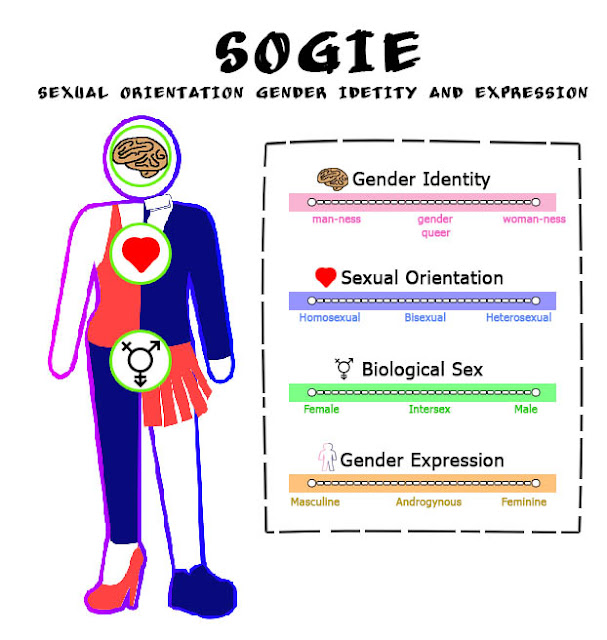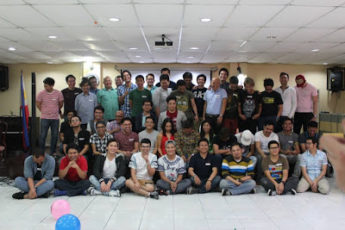SOGIE and LGBT are language tools that may still continue to evolve, used to better capture the experience of human diversity. Due to its complexity, confusion in understanding sexuality is inevitable.
The term “Third Gender” was the closest common, non-derogatory vocabulary for non-heterosexuality before the sexual revolution in the 1960s. Today, the term LGBT has been adopted by a majority of sexuality and gender identity-based communities in the United States from about 1988.[1] In the Philippines, the initialisms used are LGBT, LGBTQ, LGBTQIA, and a few others. These variations may be caused by groups giving emphasis on what the group’s main objective is and on the diversity of their members which may include queers, allies, and others that are not found in the initialism LGBT.
The initialism LGBT, the list of initials have sometimes gotten as long as LGBTTQQIAAP: lesbian, gay, bisexual, transgender, transsexual, queer, questioning, intersex, asexual, ally, pansexual1, with the possibility to continuously evolve through time. And even if there are already a lot of different identities defined, there are still those who cannot find their place within these groups.
Due to the stereotypes that exist people are implicitly limited by how they may express themselves to fit a certain criteria. Can a gay man still be gay and be attracted to a lesbian? Can a transgender man wear a dress, a blouse, or a skirt on a daily basis, and still identify as a transgender? Or can a straight person have sex with the same sex and still be called straight? The answer for all of these questions is yes. These are only some of the possible scenarios that might be confusing for some, but are true for those who experience them first hand.
In the Philippines, there exist labels within the LGBT community which may be derogatory, depending on how they are used like Pamin and Effem. Pamin (pa-men) from the word “Paminta” (Pepper) which means “like a man”, referring to masculine gay men. Effem from the word effeminate which means acting or showing characteristics of a woman. However, when used against a person, pamin is being used to address gay men who are trying to act manly are more feminine in the perception of those who see them. As for Effem, this is commonly used by people who doesn’t prefer being associated with feminine gay men usually seen on dating apps with tags like “no to effem” or “effems back off”. The terms Bakla and Tomboy are the Filipino terms for gay and lesbian respectively. Despite being accepted and used by the community, they can be derogatory depending on the manner they are used.2
These remarks are associated with a person’s characteristics, appearance, and preferences, creating dangerous stereotypes. And because a person’s behavior, perception, and judgement towards themselves and others are determined by the concepts they get from their culture3; understanding one’s Sexual Orientation Gender Identity and Expression (SOGIE) will show that these stereotypes are not enough to label the unique individualities that exist. To further simplify this concept, the illustration below provides a graphic representation of SOGIE.
The illustration shows separate categories which are independent of each other: Identity, Orientation, Sex, and Expression. This means that each person is different in where they stand in the SOGIE Spectrum.
- Sex refers to a person’s sex assigned at birth as it is expressed physiologically: defined by the X and Y chromosomes (chromosomal sex), bone structure evident in the hips and shoulders (skeletal sex), secondary characteristics like facial hair and the mammary glands, and the genitalia they are born with, which may be Male, Female, or Intersex. If a person’s Gender Identity and Sex are the same (e.g. Assigned Male at birth and identifies as a man), they are considered Cisgender, if the person’s gender identity does not match with their sex at birth, they are Transgender.
- Gender Identity refers to a person’s perception and deeply felt internal and individual experience of their own gender as a Man, Woman, or Others which may not necessarily correspond to their sex assigned at birth.4
- Sexual Orientation (Attraction) refers to an enduring pattern of emotional, romantic and/or sexual attractions to men, women or both sexes according to the American Psychological Association.5
- Gender Expression refers to the characteristics shown by the person whether they are Masculine, Feminine, or Androgynous.
One thing to remember when learning about SOGIE is that it was not designed for us to be able to define someone else’s SOGIE which oftentimes lead to bias or judgement; rather, this is a concept for individuals to be more aware of themselves and understand their own sexuality.
Mister, Miss, Mx
We no longer live in a heteronormative world; the number of unique SOGIE identification can go on and on. There is even an English language neologistic honorific title “Mx” using the letter x as a wildcard if one does not wish to refer a person by their gender which is widely accepted by the Government of the United Kingdom.6
Despite “Mx” having been introduced in the 1980’s, social media platforms have only started adapting more open gender/identity profile options.
Grindr, one of the first and most popular Gay Male Dating Applications in the country offers options for sexual identity which is categorized into three options: Man, Woman, and Non-Binary. The App also has an option for setting one’s own preferred Pronouns with an open “Custom Pronouns” option as well.
Another popular App that has been available for download along with Grindr is Scruff which also has its own way of categorizing sexuality and sexual practices in its personal account settings, placing “Bisexual” and “Transgender” along with “Leather”, “Military”, and “Discreet”
Facebook has also added a way to customize one’s own Gender in its account settings, despite not being available upon signing up from their homepage, there is a “Custom” setting which can be adjusted after creating a profile.
Not all social media platforms however are open to this. It may be because it is not an essential part of its usage like Twitter which is originally meant for quick and short updates that only has few profile information like website and birthday, or Instagram which offers “Male”, “Female” and “Not Specified” in its gender setting, which does not hinder anyone from sharing their pictures online.
Now that more people are being vocal about gender inclusivity, where there is still a thin line differentiating acceptance from tolerance, and preference from discrimination, there has already been many changes favoring equality and acceptance. One example of this is the much awaited passing of the SOGIE Equality Bill which will prevent acts of discrimination against people based on sexual orientation, gender identity or expression; it was first filed in the Philippine Congress back in the year 2000 which has already passed its 3rd reading in the Philippine Congress in 2017, and is still fighting its way through the Philippine Senate.7
As more people start to understand their own sexuality through the concept of SOGIE, the initialism LGBTTQQIAAP will keep on growing. It is not only the term “Third Gender” that changed through time, many battles for equality and acceptance has already been won; however, there are still some that are yet to be concluded. And as this concept continues on getting popularized, each individual’s understanding of their own sexuality may lead to the dissolution of discrimination and exclusion, towards inclusion and acceptance.
Text by Mark de Castro
References
1 https://en.wikipedia.org/wiki/LGBT
2 https://en.wikipedia.org/wiki/LGBT_culture_in_the_Philippines
3 http://www.psychologydiscussion.net/social-psychology-2/stereotypes/stereotypes-definition-nature-and-causes-psychology/1372
4 https://yogyakartaprinciples.org/introduction/
5 http://www.apa.org/topics/lgbt/orientation.aspx
6 https://en.wikipedia.org/wiki/Mx_(title)
7 https://en.wikipedia.org/wiki/SOGIE_Equality_Bill
https://twitter.com/?lang=en
https://www.facebook.com/
https://www.instagram.com/?hl=en



